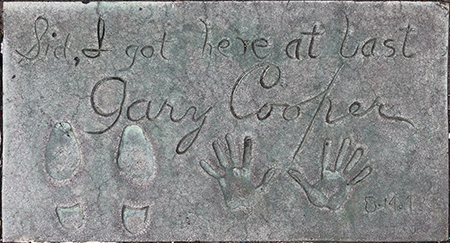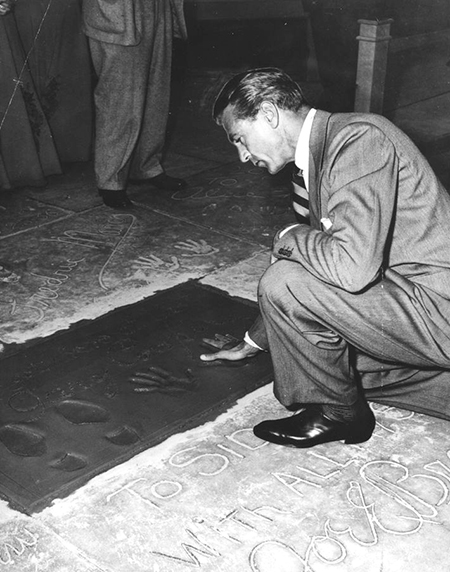 |
 |
|
|
| Gary Cooper
|
 |
| Forecourt Ceremony held on Friday, August 13, 1943 |
| |
Born: Frank James Cooper, May 7, 1901, in Helena, Montana
Age at the time of the ceremony: 42
Died: May 13, 1961, in Los Angeles, California, age 60 |
| |
Gary Cooper was one of the most successful leading men of the Golden Age of Hollywood. Coming to prominence in the early sound period, "Coop" brought a new kind of naturalistic acting to the screen, allowing him to appear in films of all kinds. Twice winning the Oscar for Best Actor, Cooper was tremendously well-liked and respected.
Born to English immigrants, Cooper's father owned a large cattle ranch, where he and his brother learned all of the tricks of the cowboy trade while also going to school in nearby Helena. During his ninth year, he was educated at Dunstable Grammar School in Bedfordshire England, which gave the young fellow a polish not usually found in frontier types.
Back in Montana at age eleven, Frank's English teacher got the young boy interested in academics; Cooper joined the debate team.
Breaking his hip at age fifteen, doctors suggested horseback riding as therepy, giving Cooper his trademark walk and riding style. An interest in art led to Grinnell College, but the drama club did not want him. In 1924, the family moved to Los Angeles, where friends introduced him to the film folk making westerns. Intending to save for college, Cooper did extra and stunt work.
Knowing the dangers of stunt work, Cooper hired an agent to try to get him acting roles; Nan Collins suggested he change his first name to Gary. By 1926, he had a contract with Sam Goldwyn for fifty bucks a week. He played a piviotal role in The Winning of Barbara Worth (released in October 1926), and was able to wiggle away from Goldwyn to Paramount, where Clara Bow chose him for roles in both Children of Divorce (released in April 1927) and Wings (released in January 1929).
By now, Cooper was headlining in his films, doing several silent features before making his first sound picture, The Virginian (released in November 1929), after which he made a number of westerns. But after being cast with Marlene Deitrich in the romance Morocco (which had its Hollywood Premiere at the Chinese in November 1930), he clashed with director Josef von Sternberg, and became something of a heartthrob in the process. He appeared as the hero in the first film adaptation of a Hemingway novel, A Farewell to Arms (released in December 1932), which became one of the big hits of the year.
He then accepted a role in Design for Living (released in December 1933) based on the Noël Coward play. Cooper was so busy, he made many more films than we have room for, but some of the more notable are:
The Lives of a Bengal Lancer (released in January 1935, Mr. Deeds Goes to Town (released in April 1936); he played Wild Bill Hicock in The Plainsman (released in November 1936).
At this time, Cooper accepted a huge offer from Sam Goldwyn, but Paramount brought suit with the court ordering the actor to work for both studios. This new work schedule resulted in Beau Geste (released in July 1939), and The Westerner (which played the Chinese in October 1940). Cooper then signed with Warner Bros., where they had a slew of projects lined up, including: Meet John Doe (released in May 1941), and the biopic of World War I hero Alvin C. York in Sergeant York (released in September 1941), which brought Cooper his first Oscar.
Pride of the Yankees (released in March 1943) had Cooper playing Lou Gehrig, which became the biggest hit of the year, then he went back to Paramount; the studio had bought the screen rights to For Whom the Bell Tolls, (released in July 1943), where Cooper and his pal Ernest Hemingway were
able to get Ingrid Bergman cast as Maria.
It was after Tolls had been released that they had Cooper down to do his footprints in the Forecourt.
He co-starred again with Ingrid Bergman in Edna Feber's Saratoga Trunk (released in March 1946), then starred in King Vidor's odd film about an architect, The Fountainhead (released in July 1949).
Fred Zinnemann's low-budget western High Noon (released in July 1952), brought Coop his second Oscar for Best Actor. In The Court-Martial of Billy Mitchell (released in December 1955), Coop played the early Air-Force booster, while in Friendly Persuasion (released in November 1956), he played the Quaker patriach of a large family in time of war.
Man of the West (released in October 1958), was one of a passel of westerns Coop made toward the end, while his final film, The Naked Edge (which had its World Premiere in Helena, Montana in June, 1961), was a thriller.
Gary Cooper had been battling prostate cancer for the last few years of his life, receiving visits and telephone calls from Queen Elizabeth II to President John F. Kennedy. He died from the cancer at the age of 60.
|
|
|
|
|
| |
 |
 |
| Grauman's Chinese Theatre, Hollywood, California. Gary Cooper Forecourt block. Executed by Jean Klossner, Friday, August 13, 1943. 50 x 27 inches. |
 |
 |
 |
| Grauman's Chinese Theatre, Hollywood, California. Cary Cooper Forecourt ceremony, Friday, August 13, 1943. Gary Cooper contemplates his handiwork after leaving his imprints in the cement. |
|
|